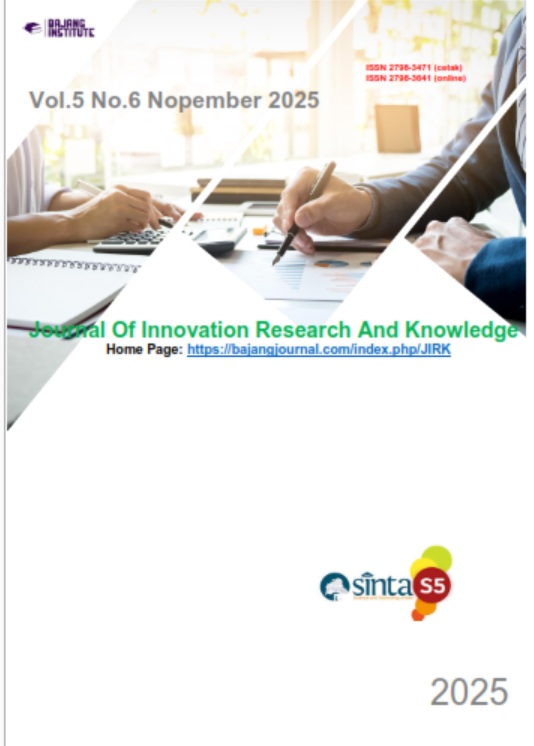NAVIGATING GROWTH AND CHALLENGES IN JAPANESE STREET FOOD BUSINESS: A STRATEGIC SWOT AND IFE-EFE ANALYSIS OF KENKAYA
Keywords:
: Japanese Street Food, Strategy, SWOT, IFE-EFEAbstract
This study aims to analyze the growth dynamics, operational challenges, and development strategies of a Japanese street food business through a case study of Kenkaya. A descriptive qualitative method was employed, supported by SWOT analysis and the use of IFE and EFE matrix as analytical tools. The findings indicate that Kenkaya's business growth is driven by product quality that suits local tastes, affordable pricing, and an attractive menu variety. Digital promotions, including Instagram advertising, online ordering platforms, and customer loyalty programs, also play a significant role in attracting new customers. However, challenges such as a non-prime location, limited operating hours, and internal staff coordination issues remain significant obstacles. Kenkaya has implemented several strategies, including price discounts, loyalty cards, menu development, and quality control of ingredients. The SWOT analysis reveals strengths in product quality and competitive pricing, with opportunities arising from increased market interest in Japanese cuisine. Meanwhile, threats come from intense market competition and environmental conditions. The IFE score of 2.75 and EFE score of 2.85 place Kenkaya in Quadrant II of the SWOT matrix, suggesting a diversification strategy to leverage internal strengths in responding to external threats.
References
Adams, E. Kathleen, Nancy Breen, and Peter J. Joski. “Impact of the National Breast and Cervic Aldianor, M. (2023). Strategi pemasaran dalam upaya meningkatkan omzet pada Kedai Megumie Ramen & Takomon di Paringin. Jurnal Bisnis Kuliner, 12(3), 102-118.
Anthony Bourdain. (2016). Anthony Bourdain’s culinary insights. [Publisher if known].
Ashkenazi, M., & Jacob, J. (2003). The essence of Japanese cuisine: An essay on food and culture. University of Pennsylvania Press.
Ashkenazi, M., & Jacob, J. (2003). The essence of Japanese cuisine. University of Pennsylvania Press.
Badan Pusat Statistik (BPS). (2020). Statistical data on Indonesian restaurants. https://www.bps.go.id/ [or exact URL if available]
Badan Pusat Statistik. (2023). Laporan pertumbuhan industri kuliner di Indonesia tahun 2023. Jakarta: BPS.
Bourdain, A. (2016). Appetites: A cookbook. HarperCollins.
Braun, V., & Clarke, V. (2006). Using thematic analysis in psychology. Qualitative Research in Psychology, 3(2), 77-101.
Cahaya Meat. (2023). Peluang usaha sushi di Indonesia dan cara berbisnisnya. Diakses dari https://cahayameat.com/blog/peluang-usaha-sushi/
Davidsson, P., Achtenhagen, L., & Naldi, L. (2006). Research on small firm growth: A review. European Institute of Technology.
Davidsson, P., Achtenhagen, L., & Naldi, L. (2006). Small firm growth. Foundations and Trends in Entrepreneurship, 2(2), 81-116.
Euromonitor International. (2023). Market research report: Japanese food market in Indonesia. London: Euromonitor International.
Fimela.com. (2021, 3 November). Keseruan nikmati sushi khas Jepang melalui kreativitas bentuk masa kini. Diakses dari https://www.fimela.com/food/read/4703587/keseruan-nikmati-sushi-khas-jepang-melalui-kreativitas-bentuk-masa-kini
Garcia, M., & Thompson, J. (2023). Community engagement and market growth in urban food entrepreneurship. International Journal of Hospitality Management, 115, 103055. https://doi.org/10.1016/j.ijhm.2023.103055
Greiner, L. E. (1972). Evolution and revolution as organizations grow. Harvard Business Review, 50(4), 37-46.
Hamda, B. I. (2021). Strategi pengembangan produk Japanese food berbasis UMKM pada The Hungry Sushi. Jurnal Manajemen Bisnis, 8(2), 134-148.
Ishige, N. (2012). The history and culture of Japanese food. London: Routledge.
Johnson, P., & Lee, S. (2022). The impact of loyalty programs on consumer retention in the foodservice industry. Journal of Consumer Marketing, 39(7), 777–789. https://doi.org/10.1108/JCM-04-2021-4841
Kim, H., Park, J., & Lee, Y. (2024). Digital marketing strategies for food businesses targeting young consumers. Journal of Interactive Marketing, 59, 10–22. https://doi.org/10.1016/j.intmar.2023.10.00
Kotler, P., & Keller, K. L. (2016). Marketing management. Pearson Education.
Liputan6.com. (2023, 15 Maret). Banyak makanan Korea viral, kenapa restoran khas Jepang tetap disukai di Indonesia. Diakses dari https://www.liputan6.com/lifestyle/read/5647015/banyak-makanan-korea-viral-kenapa-restoran-khas-jepang-tetap-disukai-di-indonesia
Maulana, R. (2021). Strategi pemasaran online pada bisnis kuliner untuk meningkatkan penjualan. Jurnal Ekonomi dan Bisnis Digital, 5(1), 55-67.
Miftahul Ulum. (2024, 5 Februari). Permintaan produk makanan asal Jepang meningkat. Bisnis.com. Diakses dari https://surabaya.bisnis.com/read/20240205/532/1738390/permintaan-produk-makanan-asal-jepang-meningkat
Moleong, L. J. (2019). Metodologi penelitian kualitatif (Revisi ed.). Bandung: PT Remaja Rosdakarya.
Nugroho, A., & Pramudito, H. (2020). Strategic collaboration in culinary SMEs: A pathway to market expansion and resilience. Journal of Entrepreneurship and Business, 5(2), 45–58.
Permatasari, D.N.C. (2021). Strategi Pengembangan Ekowisata Danau Kaenka Berdasarkan Komponen 4A Di Desa Fatukoto, NTT. Journey : Journal of Tourismpreneurship, Culinary, Hospitality, Convention and Event Management, 4(1), 1-18. https://doi.org/10.46837/journey.v4i1.68
Porter, M. E. (1985). Competitive advantage: Creating and sustaining superior performance. New York: Free Press.
Porter, M. E. (1985). Competitive advantage: Creating and sustaining superior performance. Free Press.
Rachmawati, N., Putri, A., & Santoso, B. (2021). Digital loyalty programs and consumer retention in the foodservice industry. Journal of Contemporary Marketing, 9(1), 88–102.
Rahmawati, E., Puteri, Y. E., & Aprilianti, R. (2022). Tinjauan strategi foreign branding initiative (FBI) dalam kuliner Jepang di Indonesia. Jurnal Pemasaran Global, 10(1), 75-89.
Setiawan, H., & Andriyani, R. (2022). Understanding Gen Z consumer behavior in culinary decision-making. Indonesian Journal of Marketing Studies, 4(3), 101–117.
Smith, A., & Anderson, M. (2023). Social media trends and food consumption behavior among millennials and Gen Z. Journal of Business Research, 157, 113485. https://doi.org/10.1016/j.jbusres.2023.113485
Wang, R., & Chen, L. (2023). The role of food delivery platforms in SME market expansion. Journal of Small Business Management, 61(2), 345–363. https://doi.org/10.1080/00472778.2023.2187934
Yin, R. K. (2018). Case study research and applications: Design and methods (6th ed.). Thousand Oaks, CA: SAGE Publications.













